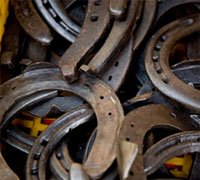 We’ve heard it said a thousand times, but the old adage remains true. Last night, Certified Journeyman Farrier Rodney King of Rood & Riddle Equine Hospital gave a talk at Alltech’s monthly News & Brews meeting. The meetings feature an expert speaker from the equine community along with refreshments and Alltech’s Kentucky Ale.
We’ve heard it said a thousand times, but the old adage remains true. Last night, Certified Journeyman Farrier Rodney King of Rood & Riddle Equine Hospital gave a talk at Alltech’s monthly News & Brews meeting. The meetings feature an expert speaker from the equine community along with refreshments and Alltech’s Kentucky Ale.
While focusing mainly on foxhunting in his own riding career these days, King has gotten to see a little of everything in the American hoofwear department. While his specialty and expertise lies in sport horse shoeing, King explained the differences in discipline-specific shoeing. “As long as the basic trim is done right—which does not differ between disciplines—you can tack anything on to the underside of the hoof that you like,” he said. As far as hoof length is concerned, “The toe should be trimmed down to the toe callus, and the heel should be trimmed back to the widest part of the frog.”
Detailed slides showed lightweight aluminum racing plates, which have to be replaced every three weeks due to the pounding of morning gallops; the smooth, wide hind shoes worn by reiners, called “sliders”; and the drilled steel shoes equipped to handle dozens of interchangeable studs for traction used by eventers. Dressage horses need wider shoes to “float” over the top of their footing, whereas endurance horses need a light-weight shoe tacked on the morning of their long ride in order for it to hold up.
It was interesting to learn how minimally hoof trimming varies between different types of horses, versus how much the shoes attached to those feet vary. King also advocated leaving a horse barefoot if his feet are robust and healthy, and don’t wear down faster than they grow. All in all, the night was a good reminder to have a skilled farrier keep up with your horse’s regular trims so he’ll remain as sound as possible.
Back to The Near Side.





We have been through many farriers. we finally started using my trainers last summer he is great!
It’s hard to find a good farrier that decently priced… sometimes you have to go with the bottom of the barrel… yikes..
Rodney is a fantastic farrier and a real professional (his wife’s awesome too!!) Good on you Rod